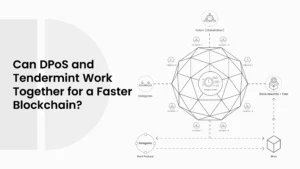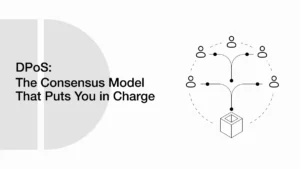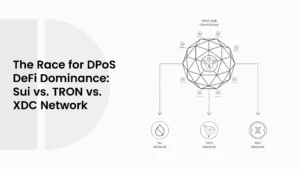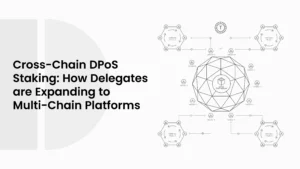How DPoS Builds Trust in Tokenized Real Estate, Art, and Gold
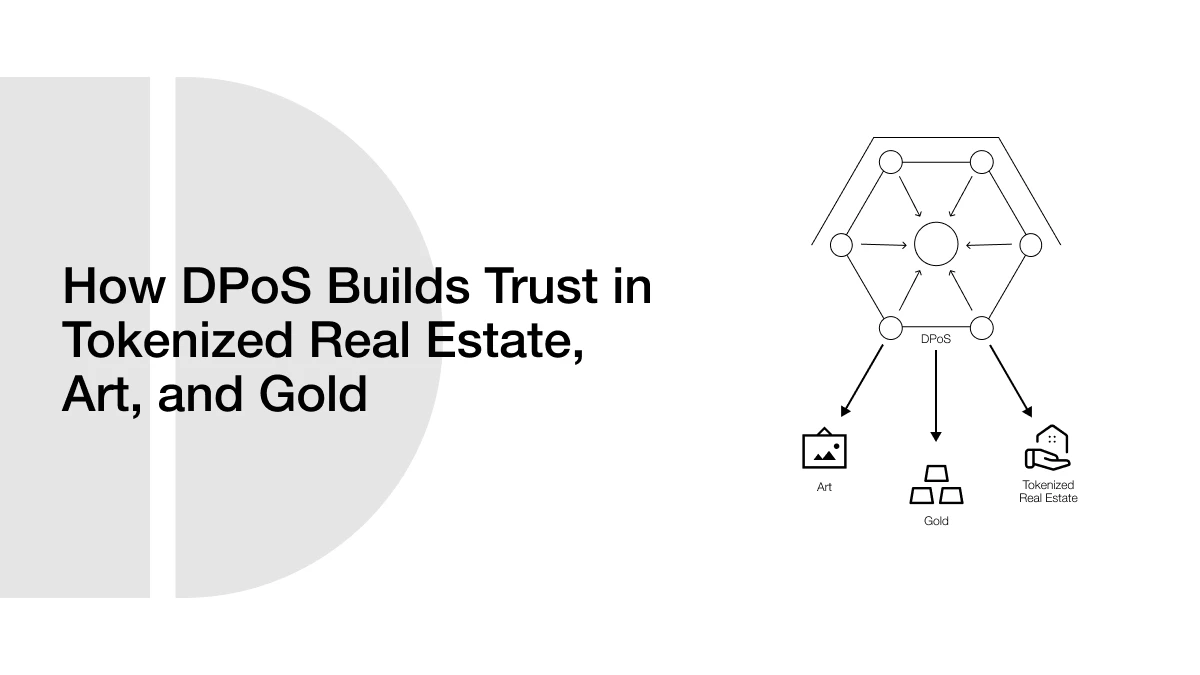
In 2025, blockchain technology is changing more than just cryptocurrencies. It’s reshaping how people buy, own, and manage real-world assets, like apartments, artwork, and gold. Tokenization is the term used for this process. It means converting a physical asset into a digital token on a blockchain. Each token represents part-ownership of that asset and can be traded easily online. What makes this exciting is that now, instead of needing thousands of dollars to invest in real estate or fine art, a person can own a small piece of it through a token. This opens up new opportunities for everyday investors around the world.
- What Is Tokenization of Real-World Assets?
- What Is DPoS and How Does It Work?
- Why Governance Matters in Tokenized Assets
- How DPoS Improves Governance for Tokenized RWAs
- Smart Contracts and Custodianship in DPoS Systems
- Smart Contracts: The Rules of the System
- Custodians: The Off-Chain Protectors
- Key Challenges of DPoS in Tokenized RWAs
- Cross-Border Legal Conflicts
- Investor Eligibility and Compliance
- Asset Valuation and Market Liquidity
- Balancing Privacy and Transparency
- Benefits of DPoS for Investors and Developers
- Lower Transaction Costs
- Faster Settlement and Ownership Updates
- Transparent and Trustworthy Governance
- Security Through Delegate Incentives
- Real-World Implementations and Test Results
- Conclusion
- Frequently Asked Questions (FAQs)
- Glossary of Terms
But tokenization alone is not enough. It needs a system to manage decisions, ownership changes, and legal responsibilities. That’s where Delegated Proof of Stake (DPoS) comes in. DPoS is a type of blockchain governance system that gives power to selected delegates who token holders choose. These delegates validate transactions, enforce rules, and help maintain the blockchain. When used with real-world assets, DPoS offers a way to manage ownership and decision-making transparently and democratically.
This blog explains how DPoS fits into the world of tokenized real assets. It explores why governance matters, how DPoS works, and the benefits and challenges of combining it with asset tokenization. We’ll use real examples, simple language, and updated research to help make sense of this important change in the way people interact with physical value in a digital world.
What Is Tokenization of Real-World Assets?
Tokenization means turning something physical, like a building, a piece of gold, or a painting, into a digital form that can be bought or sold online. A token is a digital certificate. It says that whoever owns it owns a share of the real thing. For example, if an apartment is divided into 100 tokens, each token gives 1% ownership of that property. This process lowers the amount of money needed to invest so that more people can join in. It’s part of what experts call the democratization of finance.
The market for tokenized assets is growing fast. In 2023, the World Economic Forum predicted that tokenized markets could reach $24 trillion by 2027. As of mid-2025, there are active pilot programs in cities like Chicago, London, and Zurich. These programs allow users to buy tokens linked to rental apartments, oil paintings, and even gold bars. These tokens are stored on public or private blockchains and use smart contracts to automate tasks such as rental income or dividend payments (Ravnish, 2025).
| Asset Type | Real Example | Blockchain Platform | Fractional Ownership |
| Real Estate | Apartment in Chicago | Ethereum, Polygon | 1 token = 1% property share |
| Artwork | Oil painting in London | Tezos, Ethereum | 1 token = 0.5% art ownership |
| Precious Metals | Gold stored in Zurich vaults | Avalanche, Stellar | 1 token = 1 gram of gold |
| Commercial Property | Office building in Singapore | Polygon, Qubetics Chain | 1 token = $100 worth of stake |
The value of tokenization is not just in trading pieces of a property. It also reduces paperwork, speeds up transactions, and increases transparency. Once a token is transferred, the record stays on the blockchain permanently. This helps prevent fraud and makes it easy to trace ownership.
ALSO READ: Privacy in DPoS: Why It Needs Zero-Knowledge Proofs (ZKPs) More Than Ever Now
However, tokenization brings legal questions too. Who owns the actual building if they hold a digital token? How do courts in different countries treat digital ownership? These are the questions that must be solved for tokenization to work at a global level. And this is where good governance becomes key.
What Is DPoS and How Does It Work?
Delegated proof of stake (DPoS) is one of the most efficient systems applied in blockchain networks. In contrast to Proof of Work (PoW) networks (such as Bitcoin), in which networks are secured by having computers solve mathematical problems, or Proof of Stake (PoS) networks, in which anyone with tokens can become a network validator, DPoS uses a smaller set of trusted participants known as delegates or block producers.
In a DPoS system, token holders don’t need to run complicated software to protect the network. Instead, they vote for a small number of delegates. These delegates then validate transactions, secure the blockchain, and propose updates. If a delegate misbehaves or stops performing, token holders can vote them out. This creates a system of checks and balances that helps keep the network honest.
| Feature | Proof of Work (PoW) | Proof of Stake (PoS) | Delegated Proof of Stake (DPoS) |
| Validator Selection | Solve puzzles (mining) | Based on token ownership | Voted in by token holders |
| Energy Efficiency | Very low | Medium | High |
| Speed of Transactions | Slow | Faster | Very fast |
| Governance Participation | None | Token-weighted | Token-weighted + Delegates |
| Common Use Cases | Bitcoin, Litecoin | Ethereum, Cardano | EOS, TRON, Hive, Qubetics |
Why Governance Matters in Tokenized Assets
Tokenization can turn real-world items into digital tokens. But that doesn’t mean it removes the need for rules or control. When assets are split into hundreds of digital pieces and owned by people in different countries, governance becomes even more important. Governance in this context means deciding how decisions are made, who enforces rules, and how problems get solved.
Consider 100 people who own tokens for a rental property in New York. Who decides how much rent to charge? Who handles repairs? What happens if the building is damaged? These are not technical issues; they are governance issues. Without clear answers, token holders could lose money or face legal consequences. Governance makes sure every part of the system runs fairly, transparently, and with legal backing.
A major problem with early tokenization projects was that they focused only on the technology. They used smart contracts and fast blockchains but ignored how real-world laws would apply. As a result, some projects failed when governments or courts questioned who really owned what. For tokenized assets to succeed, governance must bridge the gap between the digital world and real legal systems (De Filippi & Wright, 2018).
This is where Delegated Proof of Stake (DPoS) becomes useful. DPoS is not just a way to confirm transactions. It is also a form of governance in that the token holders elect trusted delegates. These delegates decide, make recommendations, and even accept or decline new regulations. It compares to how people elect people through democracy. In case a delegate fails to serve the interests of the community, they can be voted off by the token holders. This will make the balance of power and ensure that all the changes made to the system follow a just process.
Another benefit of DPoS governance is speed. In traditional systems, updating property ownership records can take days or even weeks. With DPoS, the process can take just minutes. Delegates are always active and ready to validate transactions, so ownership can be transferred quickly without sacrificing accuracy or trust. In testing environments like the one developed in Ravnish’s study, tokenized real estate changed hands in near real time, saving both time and money.
Finally, governance matters because tokenized assets are tied to real value. If something goes wrong, like a custodian losing paperwork, a legal dispute over title, or a missing tax filing, it affects real people and real money. Good governance systems ensure all participants are protected, all records are clear, and all decisions are fair.
| Governance Aspect | Traditional Ownership | Tokenized with DPoS |
| Decision-making power | Owner or centralized body | Delegates elected by token holders |
| Dispute resolution | Courts, lawyers | On-chain voting or arbitration modules |
| Ownership record update | Paper-based, often slow | Real-time update on blockchain |
| Compliance enforcement | Manual audits and paperwork | Automated through smart contracts |
| Global accessibility | Limited by geography and legal costs | Open to verified users worldwide |
How DPoS Improves Governance for Tokenized RWAs
Delegated Proof of Stake (DPoS) brings more than just speed and low energy use. It creates a system where real-world assets (RWAs) like buildings or gold can be governed fairly and securely on the blockchain. Governance in this setting means how decisions are made about the assets, things like who can invest, when income is paid, and how updates to the system are approved. With DPoS, all of this becomes more transparent and efficient.
ALSO READ: How Regulatory Compliance in DPoS Dawns a New Era in Blockchain Governance
In a tokenized real estate project, for example, property owners can divide a building into 1,000 tokens. Investors buy these tokens and become partial owners. But now the hard part begins: Who decides when the building is sold? What if someone wants to update the rental contract? DPoS provides an answer. Token holders vote for delegates, and these delegates represent them in major decisions. Instead of needing every investor to vote on every issue, delegates take care of daily decisions while still being held accountable by the voters (Tapscott & Tapscott, 2016).
Here’s how the process works in simple steps:
This setup works well for tokenized RWAs because it combines community control with professional management. Token holders don’t need to be experts in real estate law or financial audits. They just need to choose good delegates. And because DPoS systems are designed to make voting fast and low-cost, governance doesn’t slow down operations.
Let’s look at a real example from Ravnish’s 2025 study. In his test network, a rental apartment was tokenized on a public blockchain. Token holders elected delegates who had the power to:
- Approve tenant contracts,
- Schedule maintenance checks,
- Set rental pricing policies, and
- Propose when to sell the property.
This made the governance structure more scalable than traditional property co-ownership models, where legal filings and meetings can be slow and expensive.
Another benefit of DPoS is slashing, a rule that punishes bad behavior. If a delegate tries to cheat the system by confirming fake transactions, for example, they lose part of their stake or get removed entirely. This builds trust and ensures delegates are careful and professional in their role. Delegates often stake their own tokens as collateral, which means they have skin in the game and are less likely to act recklessly.
The DPoS model also makes it easier to add automated rules using smart contracts. These rules can:
- Distribute income (like rent or dividends),
- Verify investor identity (KYC/AML compliance),
- Enforce ownership limits, and
- Trigger votes for essential updates.
This automation removes the need for lawyers or middlemen to oversee every transaction. It reduces costs and errors. According to Ravnish’s prototype results, administrative costs dropped by almost 60% once DPoS-based automation replaced manual paperwork.
Here’s a quick comparison showing how DPoS improves governance versus older models:
| Governance Feature | Traditional Model | With DPoS Governance |
| Decision-making | Board meetings or legal filings | On-chain votes through elected delegates |
| Enforcement of rules | Lawyers, auditors | Smart contracts and slashing mechanisms |
| Participation | Limited to the board or the majority | Open to all verified token holders |
| Speed of change | Slow, manual | Fast, automated, and recorded on-chain |
| Transparency of actions | Private or hidden records | Public blockchain logs and audit trails |
Smart Contracts and Custodianship in DPoS Systems
In DPoS tokenization systems, smart contracts and custodians work side by side to manage digital ownership and protect real-world assets. This section explains how they function and why both are needed for tokenized real assets to be safe, legal, and efficient.
Smart Contracts: The Rules of the System
Smart contracts are pieces of code that run on the blockchain. Once set up, they perform tasks automatically when certain conditions are met. In tokenized real estate, for example, a smart contract might distribute monthly rent payments to all token holders without needing a landlord or accountant. If one person owns 10% of the tokens, the contract will send them 10% of the rent. This cuts down human error and saves time.
Here are common uses of smart contracts in tokenized assets:
- Dividend or rent distribution
- Trading restrictions (only verified investors can buy)
- Vote execution (if a rule change passes, the contract applies it)
- Compliance enforcement (block sales if a person fails KYC checks)
In the DSR-based prototype (Ravnish 2025), smart contracts were coded on Ethereum and Polygon. They handled fractional ownership, compliance checks, and automated income payments. These contracts followed standards like ERC-1400 and ERC-3643, which are made for regulated tokens.
But smart contracts only work for digital processes. They can’t move a real building, lock a vault, or file legal documents. That’s where custodians come in.
Custodians: The Off-Chain Protectors
A custodian is a company or trusted entity that holds the physical asset. If you buy a token representing part of a painting, the painting itself needs to be stored in a safe location. That’s the custodian’s job. They may also insure the asset, verify its legal title, or keep copies of documents.
In a tokenized system, the token only has value if the real-world asset is secure and legally connected to the token. This link is made using legal wrappers like Special Purpose Vehicles (SPVs). An SPV owns the asset, and the smart contract manages the tokens. This setup keeps the legal and digital layers in sync.
| Function | Smart Contract | Custodian |
| Automates income and voting | Yes | No |
| Verifies investor identity | Yes (with oracle or KYC integration) | No |
| Holds physical asset | No | Yes |
| Maintains legal records | No | Yes |
| Works 24/7 without people | Yes | No |
To connect both sides, oracles are used. These are tools that send data from the outside world into the blockchain. For example, an oracle might tell the smart contract that rent has been paid into a bank account, which then triggers a payment split to token holders. Together, smart contracts, custodians, and oracles form a full system of trust. If one part is missing or weak, the whole tokenized system becomes risky.
Key Challenges of DPoS in Tokenized RWAs
Even though DPoS helps make governance easier and more democratic, it’s not perfect. Tokenized real-world assets face several challenges, especially when used across different countries or asset types. This section highlights the main issues that still need work.
Cross-Border Legal Conflicts
One of the biggest problems is legal recognition. What happens if a person in the U.S. buys a token for a property in France? Will a French court agree that the token proves ownership? Many countries don’t have clear rules for on-chain property records. In the test system by Ravnish (2025), attempts to sell a European art piece to U.S. investors raised legal red flags. Without international agreements, tokenized assets remain hard to trade globally.
ALSO READ: Can DPoS Blockchains Handle Over a Billion Transactions Per Day?
Investor Eligibility and Compliance
DPoS can add rules about who is allowed to vote or hold tokens. But it still needs identity checks. In most countries, only verified investors can buy certain types of assets. Smart contracts can block unverified accounts, but if the data is wrong or the process is skipped, it causes legal problems. This makes it hard for fully open systems to stay compliant.
There is also the issue of voter engagement. If only a few token holders vote, delegates may not truly represent the group. That can lead to poor decisions or manipulation by large holders. Some DPoS systems solve this with “vote delegation,” but even that needs education and strong identity checks to work well.
Asset Valuation and Market Liquidity
Many real-world assets, like art or property, are hard to price. They don’t have live market data. In the sandbox test, token prices sometimes diverged by 12% from expert appraisals. This gap creates confusion for investors. Without standardized oracles or live valuation feeds, price discovery becomes a guessing game.
Also, many tokenized assets lack sufficient buyers and sellers. This creates a thin market, meaning small trades can swing prices up or down too fast. For a healthy market, more participants and better price data are needed.
Balancing Privacy and Transparency
DPoS is transparent; every vote, payout, and action is on-chain. But sometimes investors want privacy. For example, high-net-worth individuals may not want the world to see their art or property holdings. This raises a big question: Can we keep things open without losing confidentiality?
Privacy tools like zero-knowledge proofs may help. These let someone prove a fact (like ownership) without showing full details. Some DPoS chains are starting to add these features, but they’re still new and complex to implement (Wright & De Filippi, 2015).
Benefits of DPoS for Investors and Developers
Delegated Proof of Stake (DPoS) offers many benefits when used to manage tokenized real-world assets. These advantages help not only the developers building the system, but also the investors who use it. Below are the key benefits, explained in easy terms.
Lower Transaction Costs
Traditional ownership transfers, especially in real estate or art, involve lawyers, brokers, and government offices. This makes the process slow and expensive. DPoS systems use smart contracts to cut out the middlemen. Once the rules are written into code, the system takes care of things automatically.
In the Ravnish (2025) prototype, this automation lowered administrative costs by nearly 60%. This included fewer fees for legal checks, ownership changes, and dividend payments.
Faster Settlement and Ownership Updates
Because DPoS networks confirm blocks quickly, asset trades and ownership updates happen much faster than in traditional systems. On average, Ethereum takes about 12 seconds per block, while DPoS-based networks like EOS or Qubetics Chain settle transactions in under 3 seconds. That’s good for investors who want to trade tokens in real-time or respond quickly to market changes.
Transparent and Trustworthy Governance
In DPoS, every action, vote, delegate change, and token transfer is recorded on the blockchain. This builds trust. Investors can check what happened, when it happened, and who made the decision. There’s no need to rely on a central authority to keep records.
For developers, this clear recordkeeping reduces disputes. For investors, it reduces risk. Everyone sees the same version of the truth.
Security Through Delegate Incentives
The token holders choose delegates. If they misbehave, they can be voted out. Some systems even slash a delegate’s stake if they break the rules. That creates strong incentives to behave well and follow the rules.
Developers benefit too. They don’t need to create complex punishment systems. The DPoS model already includes ways to manage bad behavior and reward honest actors.
Real-World Implementations and Test Results
To understand how DPoS works in practice, we can look at a real prototype tested by blockchain researchers in 2025. The team, led by Ravnish, created a full system to tokenize a rental apartment and manage it using smart contracts, legal wrappers, and a DPoS-based governance model.
Here’s what they found during testing.
| Test Feature | Result | Implication |
| Fractional ownership | Worked smoothly | Access opened to small investors |
| Rental income automation | Smart contracts paid out without errors | Lower admin cost and no manual steps |
| Transparent recordkeeping | Blockchain tracked all actions | Easy audits and high trust |
| Cross-border asset sale | Blocked due to legal mismatch | Global law standards still needed |
| Token price accuracy | 10–12% price mismatch during trading | Need for stronger valuation tools and liquidity |
The test confirmed that DPoS systems can manage tokenized real assets effectively, but only when combined with the right legal and custodial tools. Fast transactions, transparent governance, and secure ownership are all possible. Yet, regulators, developers, and investors must still work together to solve issues around privacy, pricing, and legal clarity.
Conclusion
Tokenizing real-world assets gives people a way to own and trade physical value online. This includes things like homes, gold, and artwork. With just a few clicks, investors can buy a small piece of a high-value item that was once out of reach. But to make it work, the system needs strong governance, and this is where Delegated Proof of Stake (DPoS) comes in.
DPoS helps manage ownership, rules, and changes. It gives token holders the power to elect delegates who make fair decisions. It speeds up the process and removes the need for lawyers and paperwork. With smart contracts, rent and dividends are paid out automatically. With custodians, the real assets stay safe.
The research and testing done so far show that this system works. In a 2025 pilot, tokenized real estate was successfully managed using DPoS. Rent was paid automatically. Owners could vote on changes. And all actions were recorded for trust. With the right mix of tech and law, DPoS governance can change how the world buys and sells real value.
Frequently Asked Questions (FAQs)
What is DPoS?
DPoS, or Delegated Proof of Stake, is a system where token holders vote for a small group of delegates. These delegates help run the blockchain by approving transactions and decisions. It is fast, secure, and uses less energy than other systems.
How does DPoS help with tokenized real-world assets?
DPoS makes it easier to manage ownership, payments, and updates on the blockchain. Investors can vote on important changes, while smart contracts handle rent and rewards automatically. This helps reduce costs and improves fairness.
Can I really own part of a real-world asset like a house using tokens?
Yes. Tokenization allows people to own a small part (or fraction) of real-world assets like houses, gold, or art. Each token represents a legal share of the asset, often backed by contracts or custodians.
What are the risks of using DPoS for real assets?
The main risks include unclear laws in different countries, problems with asset pricing, and market liquidity. There is also a need to trust the custodians who hold the physical asset.
Is the system fully private?
No. DPoS systems are transparent by design. However, future upgrades may include privacy tools like zero-knowledge proofs (ZKPs) or permissioned blockchains to help protect investor data.
Glossary of Terms
DPoS (Delegated Proof of Stake):
A blockchain system where token holders vote for trusted delegates to validate transactions and make decisions.
Tokenization:
The process of turning real-world assets into digital tokens that can be traded on a blockchain.
Smart Contract:
Self-running code on the blockchain that automates tasks like payments or rule enforcement.
Fractional Ownership:
Owning part of an asset rather than the whole thing. For example, 10 tokens could equal 10% of a property.
Custodian:
A trusted company or party that holds and protects the real-world asset linked to the token.
Oracle:
A service that sends real-world data (like rent payments or price feeds) into the blockchain system.
ZKP (Zero-Knowledge Proof):
A privacy tool that lets someone prove ownership or rights without sharing full information.
CBDC (Central Bank Digital Currency):
A digital version of a country’s official money issued by the central bank.
Legal Wrapper / SPV:
A legal setup, often a company or contract, that connects the token to the real-world asset legally.

